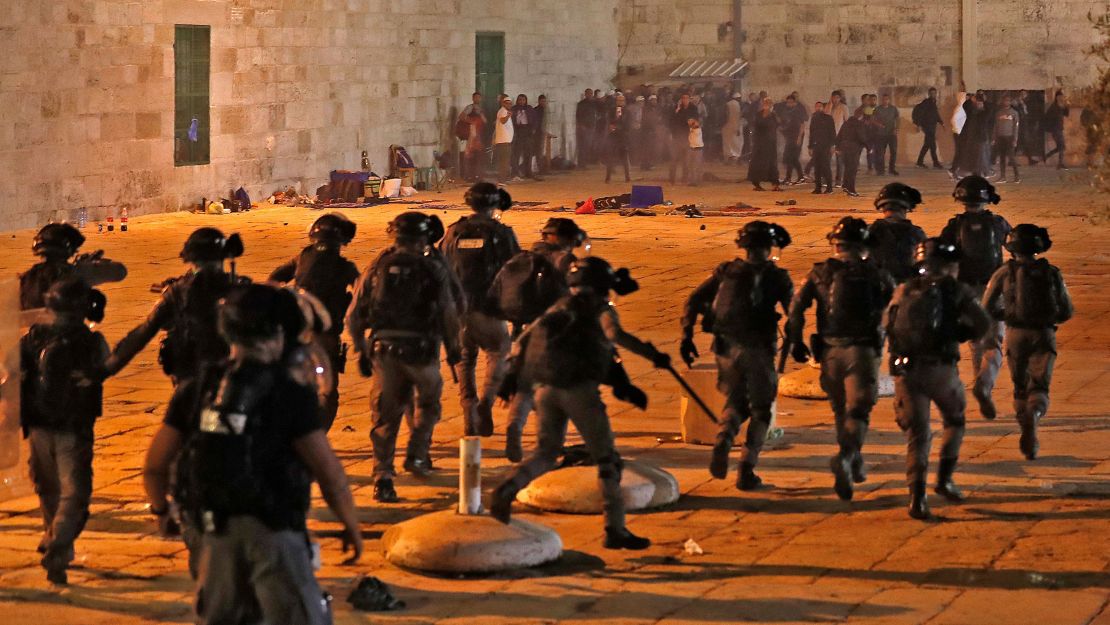“Marhaba” – hello in Arabic – began the brief text the middle-aged Jerusalem housewife found on her cell phone Monday evening. “You have been identified participating in violent acts at Al Aqsa mosque. You will be held accountable. Israeli Intelligence.”
The housewife, who lives a few minutes’ walk from the mosque, had gone to attend evening prayers. Her age and demeanor discounted the possibility she had joined hundreds of young men who had fought back with rocks and fireworks when Israeli security forces stormed into the Haram al-Sharif, or Temple Mount. Many others received an identical message on their phones, including CNN producer Kareem Khadder, who was also on the Haram al-Sharif.
I called the number from which the text was sent, and it was inactive, and it’s not clear whether the sender was indeed Israeli intelligence or someone else.
Yet one needn’t spend much time here to understand that Israel possesses all the technical means at the disposal of a 21st century government to control a restive population.


In addition to the technology that tracks the movement of individual cell phones, Israel is using drones to keep a close eye on movements in and around the Old City, aided by hundreds of closed-circuit television cameras. Thousands of armed police have been deployed to put down the current eruption of unrest, aided by police trucks that spew what Palestinians call “sewer water,” a noxious liquid sprayed at protesters, bystanders, cars, shops and houses. Israel boasts legendary internal and external intelligence services, one of the best equipped and technically advanced armed forces on Earth, plus an officially denied but no less real nuclear arsenal.
Yet despite all this, the Israeli state is struggling. Its main opponents in the streets and alleyways of Jerusalem are hundreds of mostly young Palestinian men.
Israel captured East Jerusalem, which includes the Old City, in June 1967 – its annexation shortly afterwards was never recognized by the international community. Almost 54 years later the city it claims to have reunited has never been more divided.

Dispensing with his predecessor’s passionate embrace of Israel and all its demands, President Joe Biden has reaffirmed his administration’s faith in the two-state solution, whereby Israel and a future Palestinian state would live side by side.
But that solution is a relic of a time long past. In May 2018 I covered the protests in Gaza that coincided with the opening of the US embassy in Jerusalem. The Trump administration’s unwavering endorsement of Israel’s maximalist demands were the final nails in the coffin of the two-state solution.
If it died back then, the corpse is well advanced in its decomposition. Israel’s settlement-building program in the occupied territories means that the fantasies entertained during the Oslo peace process – of East Jerusalem as the capital of a functioning Palestinian state in the West Bank and Gaza – simply isn’t viable.
Israel under the leadership of embattled hardline Prime Minister Benjamin Netanyahu has pressed its technical and diplomatic advantage to the full. Repeated inconclusive elections in recent years have put him on the defensive from an even more extreme Israeli right for whom compromise with the Palestinians is anathema. Israel’s center of gravity is now far to the right of what it was 30 years ago.

The Palestinians are divided between an aging leadership in Ramallah, led by 85-year-old Mahmoud Abbas, and the militant Hamas faction, isolated by the international community, ruling an ever more impoverished Gaza. Abbas, Palestinian Authority president since 2005, recently canceled parliamentary elections and appears content to carry on his authoritarian rule. Hamas in Gaza is increasingly unpopular for its mismanagement, oppression and corruption. Firing crude missiles at Israel may bolster Hamas’ credibility in some quarters, but the Israeli counterattacks are likely to do little more than deepen the misery of Gaza’s population.

A new generation of young Palestinians is now revolting against this status quo, taking the Israelis and the Palestinian leadership by surprise. Israel has responded with force, the Palestinian Authority with empty rhetoric, Hamas and other factions in Gaza with rockets. And none of these responses will yield anything positive.
The option that 20 years ago seemed a pipe dream, the so-called one-state solution, may be the only way to end this century-long conflict. This would involve what is today Israel proper, plus East Jerusalem, the West Bank and perhaps even Gaza, becoming one state where the same laws apply, and the same rights granted to all those living within its boundaries.
At present the area Israel effectively controls is divided between citizens of Israel and the rest, living under two legal systems, with one side enjoying full rights and protection as citizens of the state, and the other side not.
Call that set of affairs what you will. Human Rights Watch and the Israeli rights group B’tselem called it apartheid and have documented in meticulous detail exactly why they think that description fits. Israel denies it.
Yet the events in Jerusalem, Gaza and elsewhere drive home a simple fact. This conflict has reached a dead end. The old approaches to resolving it – whether through war or negotiations – have failed. Neither side can win. But all can lose.




















